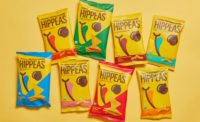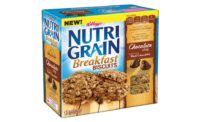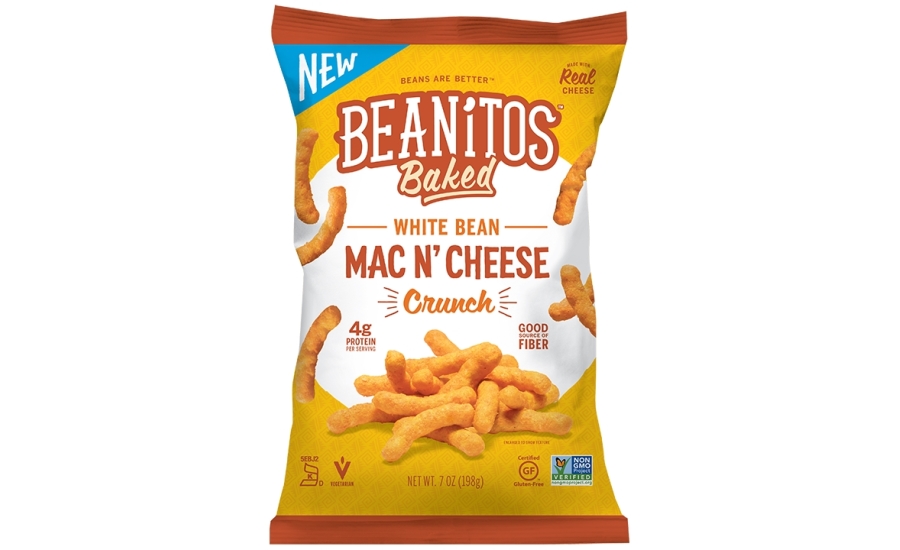Emerging brands grow the puffed and extruded snacks category
Ingredient and equipment innovation drive category diversification in puffed and extruded snacks.

PopCorners Chips

Bean Crisps

Beanitos

Harvest Snaps

Smoked Gouda Lentil Chips

Veggie Chips










The collective puffed, popped, pellet and extruded snack segment continues to see positive sales activity and a strong level of product innovation. For the 52 weeks ending Dec. 25, 2016, IRI, Chicago, reports the leading puffed and extruded segment, Other Salted Snacks (No Nuts), at $3.9 billion in sales, up 4.43 percent in dollar sales. The top growth leader for the period in the segment was Hain Celestial, up 14.97 percent to $194.1 million. Hain Celestial continues to find an increasing audience for its Sensible Portions products, and recently released the seasonal Garden Veggie Chips Mini Hearts.

The Cheese Snacks segment likewise saw growth for the period, up 6.33 percent to $2.1 billion. Corn Snacks (No Tortilla Chips) likewise saw a modest gain, up 3.48 percent to $1.1 billion. And Pork Rinds grew by 2.42 percent to $408.3 million.
While upward progress shows positive engagement with shoppers, clearly a jockeying for position is occurring in all of these puffed and extruded snack categories, with notable sales drops and increases.
PepsiCo’s Frito-Lay business dominates puffed and extruded snacks. In the Other Salted Snacks segment, Frito-Lay was up 5.28 percent to $2.4 billion, holding 61.64 percent dollar share. The top performer in the segment was the Cheetos Doritos mixed bags, up 19.96 percent to $150.9 million. The lines include various mixes of traditional and newer extruded snacks, including one product that mixes both Cheetos Flamin’ Hot and Doritos Dinamita Chile Limón rolled tortilla chips in one bag. The Frito-Lay Chester’s brand also saw growth, up 15.43 percent to $250.7 million.
Calbee North America also continues to be a standout in the Other Salted Snacks segment, with its Harvest Snaps up 17.98 percent to $82.1 million. Its original Snapea Crisps, made from green peas, have been joined by Lentil Bean Crisps in Tomato Basil and Onion Thyme, and Black Bean Crisps in Mango Chile Lime and Habanero.
In the Cheese Snacks segment, Frito-Lay again dominates, up 7.62 percent to $1.8 billion with 86.57 dollar share of the segment. The brand’s traditional Cheetos products account for much of this stronghold, taking in $1.6 billion in sales for the period, per IRI, up 8.30 percent in dollar sales and holding a 76.14 dollar share of the segment. However, in a nod to clean-label trends, Frito-Lay is diversifying the brand through its natural option, Cheetos Simply Cheese, which was up 15.67 percent to $32.1 million.
In Corn Snacks, Frito-Lay grew by 4.09 percent to $875.7 million. While Fritos are the clear leader here, up 5.34 percent to $499.0 million, the brand’s Hispanic-oriented, boldly flavored Sabritas corn snacks were up 39.89 percent to $17.9 million.
Another Hispanic brand likewise performed well in Corn Snacks, with Barcel Churritos up 15.65 percent to $9.6 million, and its Churritos Fuego products up 14.50 percent to $2.9 million. Barcel USA is Grupo Bimbo’s snacks division in the U.S.
Elsewhere in Corn Snacks, the Our Little Rebellion brand PopCorners—rebranded in 2016—saw solid traction, garnering sales of $1.9 million out of the gate.
In Pork Rinds, while Frito-Lay still rules the roost, with $123.6 million in sales and 30.27 dollar share, its products were down 5.11 percent. Meanwhile, a host of competitors saw gains, including the Evans Foods brand Mac’s (up 50.02 percent to $50.4 million), Carolina Country Snacks (up 24.93 to $8.6 million) and the Rudolph Foods brand Lee’s (up 21.17 to $6.9 million). Rudolph Foods also saw 90.01 percent growth to $2.6 million for its Southern Recipe Pork Rinds.

Trendsetters
Puffed and extruded snacks are particularly suited to better-for-you ingredient experimentation. “We are seeing an increasing number of brand owners come to us looking for Non-GMO Project Verified and certified-organic products,” says Gunther Brinkman, vice president, contract manufacturing, Ideal Snacks, Liberty, NY. “Since popped snacks are naturally low in fat, our platform is a starting point for a number of ethical and nutritional better-for-you claims.”
Brinkman notes that sprouted and ancient grains are getting more attention in this category. “Sorghum seems to be especially interesting to the brand owners we work with as a way to create a little buzz.”
Kyle Stuart, culinary scientist, Parker Products, Fort Worth, TX, believes the ancient grains trend is going to continue to build in North America. “As the consumer becomes more familiar with ancient grains such as quinoa, amaranth, sorghum and Khorasan wheat (kamut) from trends in the restaurant industry, manufactured food companies can begin to experiment with these ingredients, as well. Many of these companies are just scratching the surface of endless possibilities they present.”
Dave Reynolds, area sales manager, Bühler Aeroglide Corp., Cary, NC, cites customer interest in extruded snacks that feature vegetables, beans, pulses and leafy products, as well as dehydrated fruits.
“Extruder versatility is one of the most crucial areas of innovation,” says Stuart. “Easily interchangeable dies and adaptability is what allows companies to keep up with new ingredients and trends. Post-extrusion processing is also very popular and can be used to create crisp textures in a variety of shapes and sizes.”
Advances in technology can also help improve nutritional profiles. Bühler Aeroglide’s AeroExpander technology, notes Reynolds, uses of hot air instead of oil for 100 percent pellet expansion. This reduces costs while providing a healthier snack alternative. He notes that the expander is ideal for a broad range of pellets, including corn, rice, wheat and potato.
Brian Anderson, Ph.D., vice president, innovation and marketing, notes that Bunge, St. Louis, has invested in ways to maintain texture and flavor of ancient-grain and protein-based extruded inclusions. “With our clean-label binding agent (pre-gelatinized starch), you get a functionality similar to xanthan gum or carboxymethyl cellulose, but the only ingredient on the label is ‘corn flour,’” he says. “With our pellet extrusions, you can incorporate vegetables, fruits, legumes and ancient-grain flours. They can then be finished by air-popping, expanding or frying.”
The combination of pulse ingredients and protein has grown in popularity in puffed and extruded snacks, and Jessie Hunter, director of domestic marketing, USA Dry Pea & Lentil Council, Moscow, ID, expects this trend to continue. “We expect these trends to impact the extruded snack segment, making clean-label ingredients like pulses poised for growth in the category. We’re already starting to see this in product introductions.” Last year, for instance, she notes that Beanitos introduced White Bean Mac n’ Cheese Crunch, which has 4 grams of protein per serving and is a “good source” of fiber.
The Daily Crave, a brand owned Natural Intentions Inc., also makes strong use of pulses in its Lentil Chips, which added Smoked Gouda to the lineup in 2016. The chips have 3 grams of protein per serving.

Hunter notes that pea fiber and green lentil flour, which when incorporated in extruded puff and crisp formulations, contribute to expansion control while improving texture, mouthfeel and flavor. She says pin-milled, whole fine pea flour and hammer-milled whole pea flours have the greatest potential for extruded snacks.
According to Bunge research, notes Anderson, consumers want to see whole grains, corn, vegetables, sweet potatoes, kale and ancient grains in their extruded and puffed snacks.
Hi I’m Skinny offers several extruded snacks, including Mean & Green Superfood Sticks (made with spinach, kale, and peas) and Sweet Potato Superfood Sticks.
“Consumer demand for unique plant proteins and simplified ingredient statements are key trends in the extruded snack market,” says Chad Rieschl, senior research technologist, Cargill, Minneapolis. “In particular, we’ve seen a growing interest in using unique, non-allergenic proteins to create extruded snacks that deliver nutritional benefits and different organoleptic experiences.
“Snack makers are scrutinizing their ingredient decks and choosing label-friendly ingredients,” continues Rieschl. He suggests snack producers consider “older” ingredients, like bran, for use in extruded snacks to build appealing texture and appearance while improving nutrition.
The combination of appealing color and nutrition can grab shopper attention. “We have seen a lot of interest in our Suntava Purple Corn, not just for its color profile, which adds a nice vibrant pop to foods, but it has the added functionality of high antioxidants and anthocyanins,” says Bill Petrich, president, Suntava, Healthy Food Ingredients, Fargo, ND. “We continue to see interest in ancient grains and pulses for extruded snack applications, as well.” He notes healthy oils are in demand for extruded snacks, especially non-GMO.
Rieschl says snack producers continue to explore the possibilities of third-generation (3G) products. “Creative product developers are using new grains and other ingredients to make pellets for use in these 3G snacks. Given the popularity of high-protein snacks, a lot of work is being done to create proteins and blends that are as nutritionally beneficial and extrusion-friendly as soy.”
Snackified storytelling
“Across the board, cleaner ingredient profiles are one of the hottest trends, and one we don’t see going away anytime soon,” says Laura Kuykendall, vice president, marketing, Our Little Rebellion, Liberty, NY. But she thinks snacks can dig deeper.
“At Our Little Rebellion, we’re leading the way in ingredient transparency when it comes to extruded snacks, including PopCorners, Bean Crisps and Crinkles, all of which are Non-GMO Project Verified and made with non-GMO corn sourced from 59 small-scale farmers in Nebraska,” says Kuykendall. “This non-GMO corn is used in all Our Little Rebellion snacks, and enables us to trace every crop back to the region in which it came from and provide consumers with true ingredient transparency.”
Select snack brands can benefit from telling more of their tale. “Instead of just being focused on price, consumers are focusing on the story behind the ingredient, such as asking if the company making a social impact that they can support with their purchase,” says Petrich.
“We’re committed to educating consumers on the importance of non-GMO and why supporting U.S. family farmers is important,” says Kuykendall. “Many consumers know they want cleaner ingredients, but when they realize that eating a snack like PopCorners is also helping to support a sustainable business model for U.S. family farmers, the impact is powerful.”

Looking for a reprint of this article?
From high-res PDFs to custom plaques, order your copy today!














